A small off-white (warm white) & blue vase with decorations of flowers and ringed stripes on the top & bottom. On the bottom are what appear to be artist initials (unidentified), a crown logo, "Delft Bl" and "made in Holland" as well as an "802" sign. It appears to be under the glaze.
Vraag
I found this at an antique store, and am trying to determine the authenticity as well as the artists logo. I've searched through the available resources I could find, and cannot identify this artist or the crown logo. If anyone knows the origins and authenticity of this please let me know!
Afmetingen
11cm tall
Collectie
publiekscollectie
Merk



















Reacties 6
This is made by Zenith Gouda. second half 20th century
mvg Franky
In reply to This is made by Zenith Gouda… by FrankyStevelinck1015
Thank you so much! I was looking everywhere for this signature haha. I appreciate the information 😁
Please note, it is not hand-painted but screen printing, glazing technique, files with brush on table turntable, greetings jvdh.
Let op, is niet handgeschilderd maar zeefdruk, inglaze techniek, filé’s met penseel op tafeldraaischijfje, groet jvdh.
In reply to Please note, it is not hand… by Jan van den Heuvel1626
Thank you for the information! I sort of assumed since this was 802/?? that it was a more mass produced vase and not a unique piece. Would the bottom signature also be screen printed? Or is the bottom hand painted by the original artist who designed the piece? Forgive my translation below: 😅
Bedankt voor de informatie! Ik nam aan dat dit 802/?? dat het een meer in massa geproduceerde vaas was en geen uniek stuk. Zou de onderste handtekening ook gezeefdrukt worden? Of is de onderkant met de hand geschilderd door de oorspronkelijke kunstenaar die het stuk heeft ontworpen?
The brand is also screen printed (adhesive plate), 802 is the number of the model, crown is from 1749, the pipe makers' guild in Gouda, was obtained because of special quality, letters Z and G merged below, is Zenith Gouda, to the right the letter L, comes from libre, name of the decoration, on the left the letter V, is the initial of the surname of the decor designer, Jacobus (Jaap) Visser (1923-1988), was employed by Plateelbakkerij en Pijpenfabrieken Zenith, formerly Firma P.J. van der Want Azn. from 1937-1984. But beware, hand painting is also more or less mass work, in 1794 Gerrit Paape writes in the booklet 'De Plateelbakker or Delfsch Aardewerkmaaker' that a pottery painter can receive an order to deliver 10 or 20 dozen or more pieces, with 20 dozen that already 20 x 12 = 240 pieces, here is a photo of the designer Jaap Visser, greetings jvdh.
Ook het merk is zeefdruk (plakplaat), 802 is het nummer van het model, kroon komt uit 1749, het pijpmakersgilde te Gouda, werd verkregen wegens bijzondere kwaliteit, daaronder letters Z en G ineengevoegd, is Zenith Gouda, rechts daarvan de letter L, komt van libre, naam van de decoratie, links de letter V, is initiaal van achternaam ontwerper decor, Jacobus (Jaap) Visser (1923-1988), was in dienst bij Plateelbakkerij en Pijpenfabrieken Zenith, voorheen Firma P.J. van der Want Azn. van 1937-1984. Maar let op, ook handschilderwerk is min of meer massawerk, in 1794 schrijft Gerrit Paape in het boekje ’De Plateelbakker of Delfsch Aardewerkmaaker’ dat een plateelschilder een opdracht kan krijgen tot het leveren van 10 of 20 dozijn of meer stuks, bij 20 dozijn is dat al 20 x 12 = 240 stuks, hierbij een foto van de ontwerper Jaap Visser, groet jvdh.
Verdict:
Analysis:
Merk:
Again, wonderful responses from our dedicated community. It is truly wonderful to see the rich archival material that Jan van den Heuvel is able to provide concerning the rich history of 'Delft blue' production in the Netherlands. The mark is, as stated above, indeed by Zenith Gouda - although it can be quite hard to recognise when you've not distinguished the intertwined Z and G.
Add new comment
Only logged in users can post comments
Log in or register to post comments